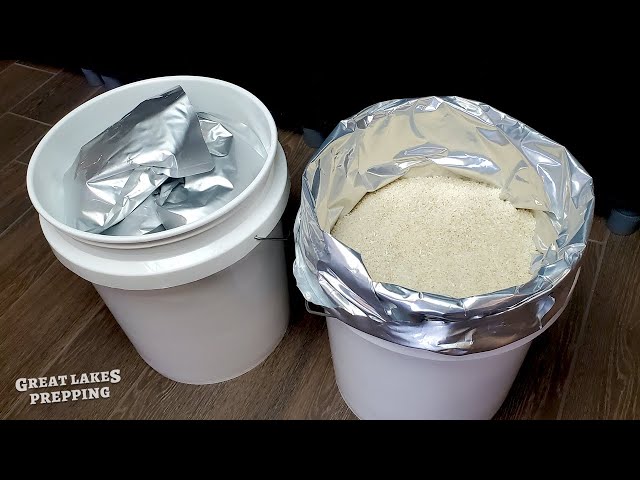Rice, the versatile and beloved staple of numerous cuisines around the world, has been sustaining humanity for thousands of years.
But did you know that storing rice for the long term is not only possible but also essential for many?
In this article, we will delve into the art of buying, storing, and cooking rice to ensure its longevity and culinary delights.
So join us on this journey as we unlock the secrets of preserving this precious grain for the years to come.
how to store rice long term
To store rice long term, it is best to use white rice as it has a longer shelf life than brown rice.
Recommended storage containers include mason jars, mylar bags, food-grade buckets, or #10 cans.
Storing rice in mylar bags and food buckets is an involved process, but it can be done by using large mylar bags, food-safe oxygen absorbers, and 5-gallon buckets.
It is important to store the rice in a dark, cool, and dry location, and precautions should be taken against rodents and vermin.
Monitoring and rotating the stockpile is also necessary.
Additionally, labeling the rice with the date of storage is recommended.
Start with a 72-hour emergency kit and consider complementing rice storage with freeze-dried vegetables and meat for convenience and diversity in food supply.
Key Points:
- White rice is best for long term storage as it has a longer shelf life than brown rice.
- Recommended storage containers include mason jars, mylar bags, food-grade buckets, or #10 cans.
- Storing rice in mylar bags and food buckets requires using large mylar bags, food-safe oxygen absorbers, and 5-gallon buckets.
- Rice should be stored in a dark, cool, and dry location to maintain its quality.
- Precautions should be taken against rodents and vermin when storing rice long term.
- Monitoring and rotating the stockpile is necessary for maintaining supplies.
- Labeling the rice with the date of storage is recommended.
- Consider complementing rice storage with freeze-dried vegetables and meat for convenience and food diversity.
how to store rice long term – Watch Video
💡
Pro Tips:
1. Did you know that rice can be stored for up to 30 years if properly sealed and stored in a cool and dark place? This makes it an excellent option for long-term emergency food storage.
2. Rice is the most important staple food for more than half of the world’s population, yet its wild ancestor, the wild rice, is a different species altogether. Wild rice is not true rice but a native aquatic grass that grows in lakes and rivers.
3. To prevent rice from spoiling during long-term storage, it is crucial to remove any pests or their eggs that may be present in the grains. Placing the rice in the freezer for a few days before storing it can eliminate any potential insect infestations.
4. Rice is not only edible but can serve practical purposes beyond the kitchen! In some Asian countries, rice powder is used in cosmetics and beauty products due to its skin-soothing and anti-inflammatory properties.
5. Rice has an interesting role in various cultures and traditions. In Japan, for example, throwing a handful of rice at weddings is considered good luck, symbolizing abundant harvests and prosperity for the newlyweds.
1. Introduction to Long-Term Storage of Rice
Storing food for long periods is a crucial part of emergency preparedness. One staple food that is commonly stored long-term is rice. Rice is an excellent item for long-term food storage as it can last for over 20 years without refrigeration or freezing. However, it is essential to store rice properly to maintain its quality and nutritional value. This article will provide valuable information on how to store rice long-term, including the recommended storage containers, step-by-step process for storage, and tips for monitoring and rotating the stockpile.
2. Benefits of Using Entrée Bucket for Long-Term Rice Storage
When considering long-term rice storage, one option to explore is the Entrée Bucket. Priced at $199.95, this bucket contains 12 bags of lunch and dinner entrées, providing a convenient and nutritious meal option. The Entrée Bucket has a total of 9,300 calories, ensuring an adequate food supply in times of need.
One of the key benefits of the Entrée Bucket is its 25-year shelf life, assuring that the rice stored within will remain viable for an extended period. Additionally, the Entrée Bucket contains clean and simple ingredients, ensuring non-GMO and no added junk. However, it is crucial to note that the Entrée Bucket’s rice content primarily consists of white rice, which is considered the best option for long-term storage.
3. Choosing the Right Type of Rice for Long-Term Storage
When choosing rice for long-term storage, it is crucial to consider both its shelf life and nutritional value. Brown rice is nutritious but has a shorter shelf life because of the bran layer. On the other hand, white rice is recommended for long-term storage due to its longer shelf life. There are different varieties of white rice, including long grain, medium grain, and short grain, all of which can be stored for an extended period without compromising quality. Before making a choice, it is essential to assess your needs and preferences.
4. Recommended Storage Containers for Rice
Storing rice correctly is crucial to maintain its freshness and protect it from contaminants. There are several recommended storage containers for rice, including mason jars, mylar bags, food-grade buckets, or #10 cans.
Each container type has its own advantages and drawbacks. Mason jars are suitable for long-term storage but require vacuum sealing or the addition of an oxygen absorber. Mylar bags are excellent for keeping out light, moisture, and air, preventing oxidation, but may be prone to pests. Food-grade buckets with high-quality lids provide extra security but must be sealed properly. #10 cans are commercially sealed containers that offer convenience, but can be challenging to access once opened.
5. Step-By-Step Process for Storing Rice in Mylar Bags and Buckets
Storing rice in mylar bags and food-grade buckets is an involved process but ensures the longevity of your rice supply. To store rice long-term, begin by acquiring large mylar bags, food-safe oxygen absorbers, and 5-gallon buckets. The amount and size of oxygen absorbers needed depend on the container used. It is recommended to use a chart to determine the appropriate amount. After sealing the mylar bags with a heat sealer or clothes iron, store them in the food-grade buckets for added security. Ensure that the buckets and lids are food-grade and high-quality. It is crucial to store the rice in a dark, cool, and dry location, preferably below 40℉. For further precautions, consider protecting the storage area from rodents and vermin.
6. Importance of Monitoring and Rotating Rice Stockpile
While storing rice long-term is essential, it is equally important to monitor and rotate the stockpile as necessary. Labeling each batch of rice with the date is recommended to keep track of its age. Periodically check the sealed packages for exposure to insects or rodents, especially for opened stocks that are periodically consumed. Over time, older rice may need to be cooked and consumed to prevent spoiling, ensuring that your supply remains fresh. It is crucial to replace the consumed rice with fresh reserves to maintain a steady and nutritious stockpile.
7. Tips for Labeling and Tracking the Age of Stored Rice
Keeping a system for labeling and tracking the age of stored rice is vital for maintaining a well-organized and updated stockpile. Labeling each container or bag with the date of storage is a simple but effective method. By doing so, you can easily identify which rice should be used first to ensure optimal freshness. It is advisable to use a permanent marker like a Sharpie to prevent the label from smudging or fading over time.
- Label each container or bag with the date of storage.
- Use a permanent marker like a Sharpie to prevent label smudging or fading.
“A well-organized and updated stockpile requires a system for labeling and tracking the age of stored rice.”
8. Complementing Rice Storage with Other Food Options for a Diverse Supply
While rice is a great choice for long-term food storage, it is important to diversify your supply with other food options for a balanced diet. Professionally prepared and packaged foods, like freeze-dried vegetables and meat, can provide convenience, reliability, and additional nutritional value to your stockpile. It is advisable to begin with a 72-hour emergency kit, as this will provide a short-term food supply before transitioning into a long-term storage plan.
9. Tips for Buying Rice in Bulk for Cost Savings
Purchasing rice in bulk can be a cost-effective strategy for long-term food storage. Ethnic grocery stores, warehouse grocery stores, and Mennonite and Church of Latter Day Saints bulk food stores are excellent places to find bulk rice options. Online options such as Country Life Natural Foods and Azure Standard also offer a wide selection of bulk rice. However, it is crucial to be aware of shipping costs, especially when buying from online stores.
10. Other Considerations for Long-Term Storage and Cooking During Power Outages
In addition to the storage information provided, there are other considerations to keep in mind for long-term rice storage and cooking during power outages. Bags of rice can be stored in the freezer to prolong their shelf life indefinitely, but it is essential to reserve freezer space for other food items. Instead, storing rice in a cool location such as a basement or under a bed is recommended.
During a power outage, two cooking options are suggested. Rinsing the rice in a strainer before adding water is advisable to remove unwanted material and reduce arsenic. For cooking over a campfire or small emergency stove, a ratio of 2 cups of water for each cup of rice, boiled together with a pinch of salt, is recommended. Stirring the rice should be avoided to prevent it from becoming mushy.
In conclusion, storing rice long-term is a crucial aspect of emergency preparedness. By following the tips and recommendations provided in this article, you can ensure the longevity, quality, and nutritional value of your rice supply. Remember to choose the right type of rice, use appropriate storage containers, monitor and rotate your stockpile, and consider complementing your supply with other food options. With proper planning and preparation, you can confidently build a long-term rice storage system that will sustain you and your family during times of need.
💡
You may need to know these questions about how to store rice long term
How do you preserve rice for a long time?
To preserve rice for a long time, it is important to store it in suitable containers in optimal conditions. One effective method is to use airtight containers such as mason jars or plastic jars with tight lids. These containers prevent moisture and air from reaching the rice, helping to maintain its quality and extend its shelf life. Additionally, storing the rice in a cool, dark, and dry place is crucial to prevent spoilage and avoid exposure to heat, light, and humidity that can accelerate degradation. Properly preserving rice ensures that you can enjoy this versatile staple for an extended period of time.
How long can you stockpile rice?
Milled rice, such as white rice, can be stockpiled for an extended period if stored correctly, making it an excellent option for long-term storage. Its shelf life is virtually indefinite when stored on the pantry shelf. On the other hand, whole grain rice, like brown rice, has a shorter shelf life of approximately six months due to the oil in the bran layer. For those seeking to extend its shelf life beyond six months, storing it in the refrigerator or freezer is recommended.
The key to maximizing the storage time of rice lies in understanding the type of rice being stored and the suitable storage methods. By properly preserving milled rice in a dry and cool pantry, it can be a reliable staple for an extended period. However, for those who prefer brown rice’s nutritional benefits, it is essential to consume or refrigerate it within six months to prevent spoilage.
How do you preserve rice for 2 years?
To further preserve rice for up to two years, it is recommended to store it in a cool and dry place. Exposing rice to excessive heat or humidity can cause it to deteriorate more quickly. Additionally, it is important to handle the rice with clean and dry utensils to prevent any bacterial contamination. By following these guidelines, rice can be successfully stored for an extended period without losing its quality or nutritional value.
How do you store a 50 pound bag of rice?
To store a 50 pound bag of rice, it is essential to maintain appropriate storage conditions. Ideally, find a cool area with a temperature below 40°F. However, if that is not possible, ensure the rice is stored in a sealed container with oxygen absorbers and a constant temperature of 70°F. By following these guidelines, the rice can be preserved for up to 10 years. For even longer storage, consider a cooler storage area with oxygen-free containers where the rice can remain edible for up to 30 years.
Reference source
https://extension.usu.edu/preserve-the-harvest/research/storing-white-rice
https://www.realsimple.com/how-to-store-rice-7095165
https://www.usarice.com/thinkrice/how-to/how-to-store-rice
https://m.timesofindia.com/life-style/food-news/can-rice-go-bad-tips-to-keep-it-fresh-for-long/photostory/80419798.cms



